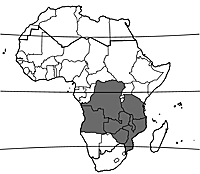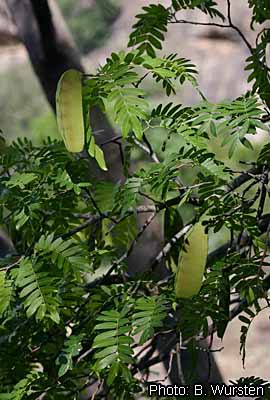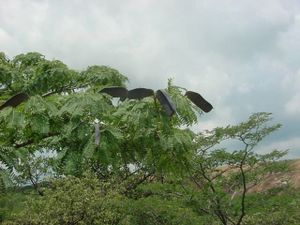Brachystegia tamarindoides (PROTA)
Introduction |
Brachystegia tamarindoides Benth.
- Protologue: Trans. Linn. Soc. London 25: 312 (1866).
- Family: Caesalpiniaceae (Leguminosae - Caesalpinioideae)
Vernacular names
- Mountain acacia, redwood (En).
Origin and geographic distribution
Brachystegia tamarindoides occurs from eastern DR Congo and Tanzania southwards to Angola, Zimbabwe and Mozambique.
Uses
The wood is locally used in house building, e.g. for flooring joist and lintels, in wagon construction, and for mine props. It is suitable for joinery, interior trim, ship building, vehicle bodies, furniture, railway sleepers (if treated), toys, novelties, turnery, veneer and plywood. It is considered an excellent source of firewood; it is in demand by farmers for curing tobacco. The wood is also important for charcoal production.
The inner bark is a source of fibre used for ropes, sacks, cloths, mats, bags, hats, bins and handicrafts. The bark is chewed to treat constipation and as anthelmintic. The foliage is browsed by livestock such as cattle and goats.
Production and international trade
The wood of Brachystegia tamarindoides is locally used and has no importance on the international timber market.
Properties
The heartwood is greyish brown to reddish brown or dark brown and is distinctly demarcated from the yellowish white, up to 10 cm wide sapwood. The grain is interlocked, texture moderately coarse to coarse. Quarter-sawn surfaces show a nice figure.
The wood is medium-weight to fairly heavy, with a density of 770–880 kg/m³ at 12% moisture content. It air dries slowly; boards of 2.5 cm thick take about 9 weeks to dry from green to air dry, with moderately severe distortion and sometimes surface checking and end splitting. The rates of shrinkage during drying are medium, from green to 12% moisture content 2.1% radial and 2.8% tangential. At 12% moisture content, the modulus of rupture is about 88 N/mm², modulus of elasticity 10,500 N/mm², compression parallel to grain 67 N/mm², shear 15 N/mm² and Janka side hardness 6450 N.
Sawing may give some difficulties because the wood has a tendency to char and splinter. Surfaces may be rough due to the interlocked grain; in planing, a reduced cutting angle to 10° is recommended. The wood has a tendency to split upon nailing, and therefore pre-boring is advised. It mortises and drills well if it is supported. The heartwood is moderately durable, being susceptible to insect attack. The sapwood is liable to attacks by blue-stain fungi and Lyctus borers. The heartwood is resistant to impregnation with preservatives, the sapwood moderately resistant.
The amount of tannin in the bark varies greatly, from 8% to 25%.
Description
- Deciduous, small to medium-sized tree up to 30(–35) m tall; bole generally straight and cylindrical, up to 80(–120) cm in diameter; bark surface smooth, silvery grey to dark grey, flaking off leaving round yellowish patches, inner bark yellowish to pinkish, becoming brown upon exposure; crown rather open, flattened, with spreading branches; twigs short-hairy to glabrous.
- Leaves alternate, paripinnately compound with 6–72 pairs of leaflets; stipules 0.5–3 cm long, usually caducous; petiole 0.2–1.5 cm long, thickened at base, rachis 5–12 cm long, grooved and slightly winged; leaflets opposite, ovate to elliptical, oblong or linear, 0.5–6 cm × 0.2–2 cm, obliquely rounded or cordate at base, acute to rounded or notched at apex, glabrous or short-hairy, pinnately veined.
- Inflorescence a terminal or axillary panicle up to 8 cm long, short-hairy.
- Flowers bisexual, nearly regular, small, fragrant, at base with 2 ovate bracteoles 4–8 mm long; pedicel 1.5–3 mm long; sepals (4–)5, slightly unequal, 2–2.5 mm long, nearly glabrous; petals absent or 1 and then c. 1.5 mm long; stamens 10, nearly free, c. 1 cm long; ovary superior, ellipsoid, 3–4 mm long, with stipe up to 3 mm long, hairy, style slender, up to 1 cm long, coiled.
- Fruit an oblong to obovoid, flattened pod 5–10 cm × 1.5–3 cm, at a right angle to the stipe, smooth but slightly wrinkled, dark brown to purplish brown, dehiscent with 2 woody valves, up to 7-seeded.
- Seeds oblong to ovoid, 1.5–2 cm long, dark brown.
Other botanical information
Brachystegia is a taxonomically difficult genus comprising about 30 species, distributed in mainland tropical Africa and South Africa, the majority of species occurring in southern tropical Africa, where they are characteristic of miombo woodland.
Three subspecies have been distinguished in Brachystegia tamarindoides: subsp. tamarindoides restricted to Angola, subsp. microphylla (Harms) Chikuni widespread throughout the distribution area of the species, and subsp. torrei (Hoyle) Chikuni occurring in Malawi, Zimbabwe and Mozambique. The latter two subspecies are sometimes distinguished as separate species, i.e. Brachystegia microphylla Harms and Brachystegia torrei Hoyle, respectively, whereas Brachystegia glaucescens Hutch. & Burtt Davy is sometimes also kept separate from subsp. microphylla on species level.
Anatomy
Wood-anatomical description (IAWA hardwood codes):
- Growth rings: 1: growth ring boundaries distinct.
- Vessels: 5: wood diffuse-porous; 13: simple perforation plates; 22: intervessel pits alternate; 23: shape of alternate pits polygonal; 26: intervessel pits medium (7–10 μm); 29: vestured pits; 30: vessel-ray pits with distinct borders; similar to intervessel pits in size and shape throughout the ray cell; 42: mean tangential diameter of vessel lumina 100–200 μm; 47: 5–20 vessels per square millimetre; 58: gums and other deposits in heartwood vessels.
- Tracheids and fibres: 61: fibres with simple to minutely bordered pits; 66: non-septate fibres present; 70: fibres very thick-walled.
- Axial parenchyma: 80: axial parenchyma aliform; 81: axial parenchyma lozenge-aliform; 83: axial parenchyma confluent; 89: axial parenchyma in marginal or in seemingly marginal bands; 91: two cells per parenchyma strand; 92: four (3–4) cells per parenchyma strand.
- Rays: 96: rays exclusively uniseriate; 97: ray width 1–3 cells; 104: all ray cells procumbent; 116: ≥ 12 rays per mm.
- Storied structure: 122: rays and/or axial elements irregularly storied.
- Mineral inclusions: 136: prismatic crystals present; 142: prismatic crystals in chambered axial parenchyma cells; (143: prismatic crystals in fibres).
Growth and development
Two years after germination, seedlings had a mean height of only 25 cm. In plantations in Burundi, trees reached a height of 7–8 m 11 years after planting. Trees are leafless in the dry season, usually in August–September. They flower in September–October and fruits ripen in April–September. When ripe, the fruits split open explosively, dispersing the seeds over some distance. The roots are associated with ectomycorrhizal fungi.
Ecology
Brachystegia tamarindoides is most common in deciduous woodland on rocky hills and escarpments, at 800–2000 m altitude. It occurs on granite soils and leached reddish soils, often in localities with thin but humus-rich soils. It is quite drought tolerant
Propagation and planting
In Zimbabwe the germination rate of seeds was only 30%, and the survival rate of seedlings after one year also 30%. Pre-treatment of the seeds by immersion in boiling water accelerates germination and improves the germination rate.
Management
Brachystegia tamarindoides is locally dominant or co-dominant with other Brachystegia spp.
Diseases and pests
The foliage is often attacked by caterpillars of the saturniid moth Imbrasia epimethea; these caterpillars are edible.
Harvesting
People typically collect branches and stems with a diameter of 3–8 cm as firewood for household fires. For use in construction and charcoal production, thicker stems and branches are collected. Big and tender shoots of young trees are often cut to extract fibre. Harvesting for all these purposes is done throughout the year.
Handling after harvest
After felling, logs should not be left for longer periods in the field because the wood is susceptible to insect attacks; they should be processed rapidly or treated with preservatives. Extracted fibre is often boiled together with ash for colouring, followed by drying. Subsequently the fibre is pressed to soften it and then spun into strands or strings.
Genetic resources
Brachystegia tamarindoides is not considered to be endangered because it is widespread and locally abundant or even dominant. However, wood exploitation for construction and charcoal production, logging for agricultural fields and uncontrolled forest fires have locally led to serious degradation of the miombo woodland in which Brachystegia tamarindoides plays an important role. In some regions, damage caused by elephants has contributed to loss of woodland with a high proportion of Brachystegia tamarindoides.
Prospects
Together with some other Brachystegia spp. from the miombo woodland, Brachystegia tamarindoides is important for local people as a source of timber, firewood, charcoal and fibre. Planting programmes have locally been initiated to counterbalance high levels of exploitation and forest degradation. More research is needed on growth rates, propagation, silvicultural methods and harvesting techniques to arrive at appropriate recommendations for sustainable forest management.
Major references
- Bolza, E. & Keating, W.G., 1972. African timbers: the properties, uses and characteristics of 700 species. Division of Building Research, CSIRO, Melbourne, Australia. 710 pp.
- Brenan, J.P.M., 1967. Leguminosae, subfamily Caesalpinioideae. In: Milne-Redhead, E. & Polhill, R.M. (Editors). Flora of Tropical East Africa. Crown Agents for Oversea Governments and Administrations, London, United Kingdom. 230 pp.
- Brummitt, R.K., Chikuni, A.C., Lock, J.M. & Polhill, R.M., 2007. Leguminosae, subfamily Caesalpinioideae. In: Timberlake, J.R., Pope, G.V., Polhill, R.M. & Martins, E.S. (Editors). Flora Zambesiaca. Volume 3, part 2. Royal Botanic Gardens, Kew, Richmond, United Kingdom. 218 pp.
- Bryce, J.M., 1966. The strength properties of Tanzania timbers. Technical Note No 35. Tanzania Forest Division, Utilisation Section, Moshi, Tanzania. 17 pp.
- Bryce, J.M., 1967. The commercial timbers of Tanzania. Tanzania Forest Division, Utilisation Section, Moshi, Tanzania. 139 pp.
- Coates Palgrave, K., 2002. Trees of southern Africa. 3rd Edition. Struik Publishers, Cape Town, South Africa. 1212 pp.
- Coates Palgrave, O.H., 1957. Trees of Central Africa. National Publications Trust, Rhodesia and Nyasaland, Salisbury, Southern Rhodesia. 466 pp.
- Gerhardt, K. & Nemarundwe, N., 2006. Participatory planting and management of indigenous trees: lessons from Chivi District, Zimbabwe. Agriculture and Human Values 23(2): 231–243.
- Takahashi, A., 1978. Compilation of data on the mechanical properties of foreign woods (part 3) Africa. Shimane University, Matsue, Japan. 248 pp.
- Wilczek, R., Léonard, J., Hauman, L., Hoyle, A.C., Steyaert, R., Gilbert, G. & Boutique, R., 1952. Caesalpiniaceae. In: Robyns, W., Staner, P., Demaret, F., Germain, R., Gilbert, G., Hauman, L., Homès, M., Jurion, F., Lebrun, J., Vanden Abeele, M. & Boutique, R. (Editors). Flore du Congo belge et du Ruanda-Urundi. Spermatophytes. Volume 3. Institut National pour l’Étude Agronomique du Congo belge, Brussels, Belgium. pp. 234–554.
Other references
- Allen, O.N. & Allen, E.K., 1981. The Leguminosae: a source book of characteristics, uses and nodulation. MacMillan, London, United Kingdom. 812 pp.
- Bongo, P.P. & Bourdillon, M.F.C., 2000. Intervention in natural resource use in Biriwiri, Zimbabwe. Zambezia 108(2): 133–146.
- Campbell, B. (Editor), 1996. The miombo in transition: woodlands and welfare in Africa. Centre for International Forestry Research (CIFOR), Bogor, Indonesia. 266 pp.
- Hyde, M.A. & Wursten, B., 2011. Brachystegia tamarindoides subsp. microphylla. [Internet] Flora of Zimbabwe http://www.zimbabweflora.co.zw/speciesdata/genus.php?genus_id=126620. December 2011.
- Tafangenyasha, C., 2001. Decline of the mountain acacia, Brachystegia glaucescens in Gonarezhou National Park, southeast Zimbabwe. Journal of Environmental Management 63: 37–50.
- Wilczek, R., Léonard, J., Hauman, L., Hoyle, A.C., Steyaert, R., Gilbert, G. & Boutique, R., 1952. Caesalpiniaceae. In: Robyns, W., Staner, P., Demaret, F., Germain, R., Gilbert, G., Hauman, L., Homès, M., Jurion, F., Lebrun, J., Vanden Abeele, M. & Boutique, R. (Editors). Flore du Congo belge et du Ruanda-Urundi. Spermatophytes. Volume 3. Institut National pour l’Étude Agronomique du Congo belge, Brussels, Belgium. pp. 234–554.
- Williamson, J., 1955. Useful plants of Nyasaland. The Government Printer, Zomba, Nyasaland. 168 pp.
Sources of illustration
- Brenan, J.P.M., 1967. Leguminosae, subfamily Caesalpinioideae. In: Milne-Redhead, E. & Polhill, R.M. (Editors). Flora of Tropical East Africa. Crown Agents for Oversea Governments and Administrations, London, United Kingdom. 230 pp.
- Coates Palgrave, K., 2002. Trees of southern Africa. 3rd Edition. Struik Publishers, Cape Town, South Africa. 1212 pp.
Author(s)
- L. Jimu, Forestry Unit, Department of Environmental Science, Bindura University of Science Education (BUSE), P.B. 1020, Bindura, Zimbabwe
Correct citation of this article
Jimu, L., 2012. Brachystegia tamarindoides Benth. [Internet] Record from PROTA4U. Lemmens, R.H.M.J., Louppe, D. & Oteng-Amoako, A.A. (Editors). PROTA (Plant Resources of Tropical Africa / Ressources végétales de l’Afrique tropicale), Wageningen, Netherlands. <http://www.prota4u.org/search.asp>.
Accessed 3 April 2025.
- See the Prota4U database.









